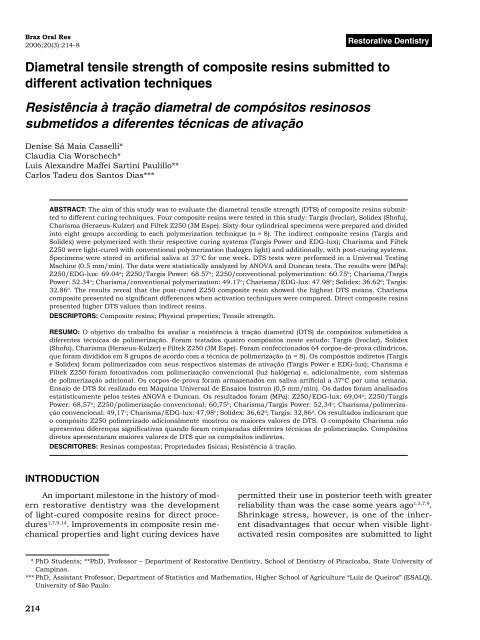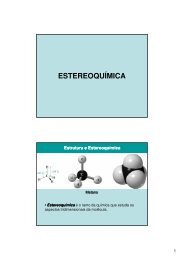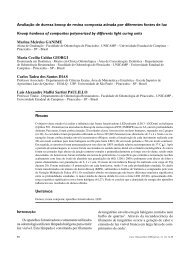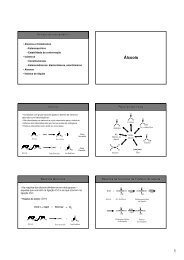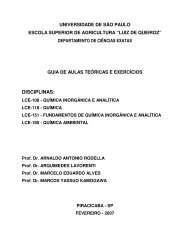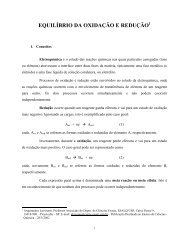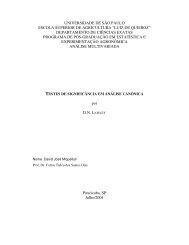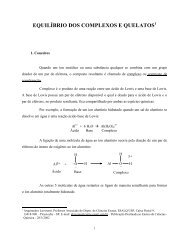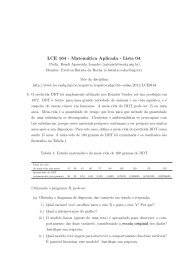Diametral tensile strength of composite resins submitted to different ...
Diametral tensile strength of composite resins submitted to different ...
Diametral tensile strength of composite resins submitted to different ...
You also want an ePaper? Increase the reach of your titles
YUMPU automatically turns print PDFs into web optimized ePapers that Google loves.
Res<strong>to</strong>rative Dentistry<br />
Braz Oral Res<br />
2006;20(3):214-8<br />
<strong>Diametral</strong> <strong>tensile</strong> <strong>strength</strong> <strong>of</strong> <strong>composite</strong> <strong>resins</strong> <strong>submitted</strong> <strong>to</strong><br />
<strong>different</strong> activation techniques<br />
Resistência à tração diametral de compósi<strong>to</strong>s resinosos<br />
submetidos a diferentes técnicas de ativação<br />
Denise Sá Maia Casselli*<br />
Claudia Cia Worschech*<br />
Luis Alexandre Maffei Sartini Paulillo**<br />
Carlos Tadeu dos San<strong>to</strong>s Dias***<br />
214<br />
ABSTRACT: The aim <strong>of</strong> this study was <strong>to</strong> evaluate the diametral <strong>tensile</strong> <strong>strength</strong> (DTS) <strong>of</strong> <strong>composite</strong> <strong>resins</strong> <strong>submitted</strong><br />
<strong>to</strong> <strong>different</strong> curing techniques. Four <strong>composite</strong> <strong>resins</strong> were tested in this study: Targis (Ivoclar), Solidex (Sh<strong>of</strong>u),<br />
Charisma (Heraeus-Kulzer) and Filtek Z250 (3M Espe). Sixty-four cylindrical specimens were prepared and divided<br />
in<strong>to</strong> eight groups according <strong>to</strong> each polymerization technique (n = 8). The indirect <strong>composite</strong> <strong>resins</strong> (Targis and<br />
Solidex) were polymerized with their respective curing systems (Targis Power and EDG-lux); Charisma and Filtek<br />
Z250 were light-cured with conventional polymerization (halogen light) and additionally, with post-curing systems.<br />
Specimens were s<strong>to</strong>red in artifi cial saliva at 37°C for one week. DTS tests were performed in a Universal Testing<br />
Machine (0.5 mm/min). The data were statistically analyzed by ANOVA and Duncan tests. The results were (MPa):<br />
Z250/EDG-lux: 69.04a ; Z250/Targis Power: 68.57a ; Z250/conventional polymerization: 60.75b ; Charisma/Targis<br />
Power: 52.34c ; Charisma/conventional polymerization: 49.17c ; Charisma/EDG-lux: 47.98c ; Solidex: 36.62d ; Targis:<br />
32.86d . The results reveal that the post-cured Z250 <strong>composite</strong> resin showed the highest DTS means. Charisma<br />
<strong>composite</strong> presented no signifi cant differences when activation techniques were compared. Direct <strong>composite</strong> <strong>resins</strong><br />
presented higher DTS values than indirect <strong>resins</strong>.<br />
DESCRIPTORS: Composite <strong>resins</strong>; Physical properties; Tensile <strong>strength</strong>.<br />
RESUMO: O objetivo do trabalho foi avaliar a resistência à tração diametral (DTS) de compósi<strong>to</strong>s submetidos a<br />
diferentes técnicas de polimerização. Foram testados quatro compósi<strong>to</strong>s neste estudo: Targis (Ivoclar), Solidex<br />
(Sh<strong>of</strong>u), Charisma (Heraeus-Kulzer) e Filtek Z250 (3M Espe). Foram confeccionados 64 corpos-de-prova cilíndricos,<br />
que foram divididos em 8 grupos de acordo com a técnica de polimerização (n = 8). Os compósi<strong>to</strong>s indire<strong>to</strong>s (Targis<br />
e Solidex) foram polimerizados com seus respectivos sistemas de ativação (Targis Power e EDG-lux); Charisma e<br />
Filtek Z250 foram fo<strong>to</strong>ativados com polimerização convencional (luz halógena) e, adicionalmente, com sistemas<br />
de polimerização adicional. Os corpos-de-prova foram armazenados em saliva artifi cial a 37°C por uma semana.<br />
Ensaio de DTS foi realizado em Máquina Universal de Ensaios Instron (0,5 mm/min). Os dados foram analisados<br />
estatisticamente pelos testes ANOVA e Duncan. Os resultados foram (MPa): Z250/EDG-lux: 69,04a ; Z250/Targis<br />
Power: 68,57a ; Z250/polimerização convencional: 60,75b ; Charisma/Targis Power: 52,34c ; Charisma/polimerização<br />
convencional: 49,17c ; Charisma/EDG-lux: 47,98c ; Solidex: 36,62d ; Targis: 32,86d . Os resultados indicaram que<br />
o compósi<strong>to</strong> Z250 polimerizado adicionalmente mostrou os maiores valores de DTS. O compósi<strong>to</strong> Charisma não<br />
apresen<strong>to</strong>u diferenças signifi cativas quando foram comparadas diferentes técnicas de polimerização. Compósi<strong>to</strong>s<br />
dire<strong>to</strong>s apresentaram maiores valores de DTS que os compósi<strong>to</strong>s indire<strong>to</strong>s.<br />
DESCRITORES: Resinas compostas; Propriedades físicas; Resistência à tração.<br />
INTRODUCTION<br />
An important miles<strong>to</strong>ne in the his<strong>to</strong>ry <strong>of</strong> modern<br />
res<strong>to</strong>rative dentistry was the development<br />
<strong>of</strong> light-cured <strong>composite</strong> <strong>resins</strong> for direct procedures<br />
1,7,9,14 . Improvements in <strong>composite</strong> resin mechanical<br />
properties and light curing devices have<br />
Res<strong>to</strong>rative Dentistry<br />
permitted their use in posterior teeth with greater<br />
reliability than was the case some years ago 1,3,7,9 .<br />
Shrinkage stress, however, is one <strong>of</strong> the inherent<br />
disadvantages that occur when visible lightactivated<br />
resin <strong>composite</strong>s are <strong>submitted</strong> <strong>to</strong> light<br />
* PhD Students; **PhD, Pr<strong>of</strong>essor – Department <strong>of</strong> Res<strong>to</strong>rative Dentistry, School <strong>of</strong> Dentistry <strong>of</strong> Piracicaba, State University <strong>of</strong><br />
Campinas.<br />
*** PhD, Assistant Pr<strong>of</strong>essor, Department <strong>of</strong> Statistics and Mathematics, Higher School <strong>of</strong> Agriculture “Luiz de Queiroz” (ESALQ),<br />
University <strong>of</strong> São Paulo.
Casselli DSM, Worschech CC, Paulillo LAMS, Dias CTS. <strong>Diametral</strong> <strong>tensile</strong> <strong>strength</strong> <strong>of</strong> <strong>composite</strong> <strong>resins</strong> <strong>submitted</strong> <strong>to</strong> <strong>different</strong> activation<br />
techniques. Braz Oral Res 2006;20(3):214-8.<br />
polymerization. Direct <strong>composite</strong>s have also been<br />
associated with undesirable characteristics such<br />
as excessive wear, deficient interproximal contacts,<br />
microleakage and pos<strong>to</strong>perative sensitivity 1,7,9,12 .<br />
Indirect systems became popular <strong>to</strong> overcome<br />
these limitations <strong>of</strong> direct res<strong>to</strong>rations 12,13 .<br />
Post-curing <strong>of</strong> light-cure <strong>composite</strong> material was<br />
introduced more than a decade ago 1,6-8,10,13,15 . Res<strong>to</strong>rations<br />
manufactured with light-cured resin <strong>composite</strong><br />
material were removed from model or <strong>to</strong>oth<br />
and placed in a special curing oven for a period <strong>of</strong><br />
time. The oven provides heat and light and ensures<br />
optimal curing and conversion <strong>of</strong> the resin 6,13,15 .<br />
Specifically, addition <strong>of</strong> heat may improve physical<br />
diametral <strong>tensile</strong> properties 13,15 , compressive and<br />
flexural <strong>strength</strong>s 15 , wear resistance, hardness 13 ,<br />
and polymerization conversion 6,8 . Achieving adequate<br />
depth <strong>of</strong> cure <strong>of</strong> radiation-activated polymers<br />
is important <strong>to</strong> ensure optimal mechanical properties<br />
<strong>of</strong> the res<strong>to</strong>ration 1,4,13-14,16 . Thus, the physical<br />
properties <strong>of</strong> the resin are enhanced and the effects<br />
<strong>of</strong> polymerization shrinkage are minimized 10 .<br />
On the other hand, there are problems related<br />
<strong>to</strong> the chemistry <strong>of</strong> cured <strong>composite</strong>, particularly<br />
<strong>to</strong> the degree <strong>of</strong> conversion and cross-linking density<br />
2,11,16 . It may be influenced by many fac<strong>to</strong>rs including<br />
chemical structure <strong>of</strong> the monomers, light<br />
illumination time and intensity needed <strong>to</strong> activate<br />
polymerization, and filler composition 1,14,16 . Investigation<br />
in<strong>to</strong> the effect <strong>of</strong> post-curing on the properties<br />
<strong>of</strong> dental materials would be beneficial for the<br />
development <strong>of</strong> res<strong>to</strong>rative dental materials.<br />
Filler content, filler particle size and distribution<br />
<strong>of</strong> the filler particles all highly influence the<br />
physical and mechanical properties <strong>of</strong> the <strong>composite</strong><br />
materials 2,4,11,14,16 . Manufacturers have increased the<br />
filler content and reduced the average filler particle<br />
size <strong>to</strong> produce resin-based <strong>composite</strong> materials for<br />
Class II posterior res<strong>to</strong>rations, which need adequate<br />
<strong>strength</strong> and wear resistance <strong>to</strong> withstand mastica<strong>to</strong>ry<br />
forces <strong>to</strong> which they are subjected 9,14,16 .<br />
These posterior resin-based <strong>composite</strong>s have<br />
basically the same chemistry and physical characteristics,<br />
however the cure conditions still are the<br />
most important difference between them.<br />
The purpose <strong>of</strong> this investigation was <strong>to</strong> examine<br />
the diametral <strong>tensile</strong> <strong>strength</strong> <strong>of</strong> <strong>composite</strong> <strong>resins</strong><br />
<strong>submitted</strong> <strong>to</strong> <strong>different</strong> light activation techniques.<br />
MATERIALS AND METHODS<br />
Four commercially available light-cured <strong>composite</strong><br />
resin res<strong>to</strong>rative materials, namely, Solidex<br />
(Sh<strong>of</strong>u, Higashiyama-Ku, Kyo<strong>to</strong>, Japan), Targis<br />
(Ivoclar Vivadent Pty Ltd., Noble Park North, Melbourne<br />
Vic<strong>to</strong>ria, Australia), Charisma (Heraeus-Kulzer,<br />
Gonsennheumer, Mainz, Germany) and Filtek<br />
Z250 (3M Espe, St. Paul, MN, USA), shade A3, were<br />
tested. These materials are described in Table 1.<br />
The materials were handled according <strong>to</strong> the<br />
manufacturer’s instructions. Teflon split molds<br />
(Cometa S.A., Piracicaba, SP, Brazil) with 3 mm<br />
in depth and 6 mm in diameter were used <strong>to</strong> prepare<br />
the cylindrical specimens, according <strong>to</strong> ADA<br />
specification #27, item 5.<br />
The <strong>resins</strong> were used in incremental layers,<br />
ranging from 1.0 <strong>to</strong> 1.5 mm in height, and they<br />
were cured according <strong>to</strong> the experimental groups.<br />
Eight specimens were made for each group.<br />
G1: Specimens were made with Solidex resin<br />
and each layer was cured for 90 seconds. After that,<br />
specimens were heat-light cured for 7 minutes, using<br />
an EDG-lux high-intensity xenon pho<strong>to</strong>-curing<br />
unit machine (EDG, São Carlos, SP, Brazil). G2:<br />
Specimens were made with Targis resin and each<br />
layer was cured for 20 seconds (Targis Quick - light<br />
curing). After that, specimens were post-cured for<br />
25 minutes, using a special machine (Targis Power<br />
– heat-light curing). G3: Charisma <strong>composite</strong> resin<br />
was cured with a light curing unit (Degulux S<strong>of</strong>t<br />
TABLE 1 - Composition <strong>of</strong> <strong>composite</strong> <strong>resins</strong> evaluated<br />
in the present study.<br />
Brand Manufacturer Composition<br />
Solidex Sh<strong>of</strong>u<br />
Targis Ivoclar<br />
Charisma Kulzer<br />
Z250 3M/Espe<br />
• 53% inorganic and<br />
ceramic micr<strong>of</strong>ilaments;<br />
• 25% co-polymers <strong>of</strong><br />
multi-functional <strong>resins</strong>;<br />
• 22% conventional <strong>resins</strong>/light-initia<strong>to</strong>rs<br />
• Urethane dimethacrylate;<br />
• Decanediol dymethacrylate<br />
Bis-GMA;<br />
• Barium glass, mixed<br />
oxide;<br />
• Silicon Dioxide<br />
• 64% <strong>of</strong> filler: Barium<br />
aluminium fluoride<br />
glass;<br />
• Bis-GMA and TEG-<br />
DMA<br />
• Bis-GMA, UDMA and<br />
Bis-EMA;<br />
• 66% <strong>of</strong> filler: Zirconium/Silica<br />
215
Casselli DSM, Worschech CC, Paulillo LAMS, Dias CTS. <strong>Diametral</strong> <strong>tensile</strong> <strong>strength</strong> <strong>of</strong> <strong>composite</strong> <strong>resins</strong> <strong>submitted</strong> <strong>to</strong> <strong>different</strong> activation<br />
techniques. Braz Oral Res 2006;20(3):214-8.<br />
Start, Degussa Hills, Hanau, Germany) with a light<br />
intensity <strong>of</strong> 400 <strong>to</strong> 700 mW/cm² for 40 seconds per<br />
layer (conventional polymerization). G4: Charisma<br />
<strong>composite</strong> resin was light-cured through conventional<br />
polymerization. After that, it was post-cured<br />
in an EDG-lux oven, by heat-light activation, during<br />
7 minutes. G5: Charisma <strong>composite</strong> resin was<br />
light-cured through conventional polymerization.<br />
After that, it was post-cured using a specific machine<br />
for Targis resin activation (Targis Power),<br />
during 25 minutes. G6: Z250 <strong>composite</strong> resin was<br />
light-cured through conventional polymerization.<br />
G7: Z250 <strong>composite</strong> resin was light-cured through<br />
conventional polymerization. After that, it was<br />
post-cured using the special machine EDG-lux<br />
during 7 minutes. G8: Z250 <strong>composite</strong> resin was<br />
light-cured through conventional polymerization.<br />
After that, it was post-cured using Targis Power<br />
during 25 minutes.<br />
The prepared specimens were s<strong>to</strong>red in a lightpro<strong>of</strong><br />
container with artificial saliva at 37°C for<br />
1 week. <strong>Diametral</strong> Tensile Strength (DTS) testing<br />
was performed using a Universal Testing Machine<br />
(Instron Corporation, Can<strong>to</strong>n, MA) at a crosshead<br />
speed <strong>of</strong> 0.5 mm/min. Specimens were positioned<br />
vertically on the testing machine base and subjected<br />
<strong>to</strong> compressive load until failure. Mean DTS<br />
values were expressed in MPa and the data were<br />
analyzed by ANOVA, followed by Duncan’s test at<br />
the 0.05 level <strong>of</strong> significance.<br />
RESULTS<br />
The values obtained through DTS testing were<br />
subjected <strong>to</strong> analysis <strong>of</strong> variance (ANOVA), which<br />
revealed significant differences among the experimental<br />
groups. In order <strong>to</strong> document these results,<br />
Duncan’s test was applied (Table 2).<br />
The Duncan test showed that a major range<br />
<strong>of</strong> DTS values was presented by group Z250 with<br />
post-curing using EDG-lux (G7). This group did<br />
not show statistical differences in relation <strong>to</strong> the<br />
Z250 resin group which was post-cured with Targis<br />
Power (G8). The group Z250 with conventional<br />
polymerization (G6) showed smaller values than<br />
G7 and G8.<br />
Specimens <strong>of</strong> Targis resin (G2) showed the<br />
smallest values <strong>of</strong> DTS and did not show differences<br />
in relation <strong>to</strong> the Solidex group (G1). For<br />
the Charisma groups, no significant difference was<br />
found between the activation modes (Graph 1).<br />
These groups showed intermediate DTS values.<br />
216<br />
TABLE 2 - Mean diametral <strong>tensile</strong> <strong>strength</strong> values for<br />
the experimental groups (MPa).<br />
Experimental group<br />
DISCUSSION<br />
Mean<br />
DTS<br />
Statistical<br />
Grouping<br />
Z250/EDG-lux (G7) 69.036 a<br />
Z250/Targis Power (G8) 68.568 a<br />
Z250 (conventional<br />
polymerization) (G6)<br />
60.751 b<br />
Charisma/Targis Power (G5) 52.340 c<br />
Charisma (conventional<br />
polymerization) (G3)<br />
49.166 c<br />
Charisma/EDG-lux (G4) 47.981 c<br />
Solidex (G1) 36.622 d<br />
Targis (G2) 32.862 d<br />
<strong>Diametral</strong> Tensile Strength (DTS)<br />
70<br />
60<br />
50<br />
40<br />
30<br />
20<br />
10<br />
0<br />
69.03<br />
Z250/EDGIux<br />
68.56<br />
Z250/Targis Power<br />
60.75<br />
Z250<br />
52.34<br />
Charisma/Targis Power<br />
Charisma<br />
GRAPH 1 - Results <strong>of</strong> <strong>Diametral</strong> Tensile Strength (MPa)<br />
for the tested materials.<br />
Composite resin polymerization occurs by<br />
the conversion <strong>of</strong> the monomer molecules in<strong>to</strong> a<br />
polymer network, accompanied by a closer packing<br />
<strong>of</strong> the molecules, causing contraction in the<br />
<strong>composite</strong> 1,2,11 . Polymerization shrinkage creates<br />
stress on the res<strong>to</strong>red <strong>to</strong>oth that may result in poor<br />
marginal integrity, and inadequate durability and<br />
longevity in the oral environment 9,12 . These fac<strong>to</strong>rs<br />
are related <strong>to</strong> the chemistry <strong>of</strong> dental <strong>composite</strong>s,<br />
particularly <strong>to</strong> the degree <strong>of</strong> conversion (DC) and<br />
the cross-linking density 4,12,14,16 .<br />
DTS is an acceptable and common test for<br />
dental <strong>composite</strong>s 1,5,13-16 . The DTS values <strong>of</strong> the<br />
49.16<br />
47.98<br />
Charisma/EDGlux<br />
36.62<br />
Solidex<br />
32.86<br />
Targis
Casselli DSM, Worschech CC, Paulillo LAMS, Dias CTS. <strong>Diametral</strong> <strong>tensile</strong> <strong>strength</strong> <strong>of</strong> <strong>composite</strong> <strong>resins</strong> <strong>submitted</strong> <strong>to</strong> <strong>different</strong> activation<br />
techniques. Braz Oral Res 2006;20(3):214-8.<br />
<strong>composite</strong>s tested in the present study are in the<br />
DTS range <strong>of</strong> dental <strong>composite</strong>s, 30-55 MPa 16 . In<br />
the present study, the <strong>composite</strong> DTS values were<br />
in the 30 <strong>to</strong> 70 MPa range, which are acceptable<br />
values for <strong>composite</strong>s.<br />
A positive correlation has been demonstrated<br />
between the degree <strong>of</strong> monomer <strong>to</strong> polymer conversion<br />
(DC) and mechanical properties <strong>of</strong> <strong>composite</strong>s<br />
4,8,14,16 . Degree <strong>of</strong> monomer conversion (DC) and<br />
cross-linking density in <strong>composite</strong>s are influenced<br />
by many fac<strong>to</strong>rs, including monomeric composition,<br />
light intensity, curing time and filler content<br />
in the resin matrix 3,4,8,11,14,16 .<br />
The highest mean <strong>of</strong> DTS was observed for<br />
post-cured Z250 groups, and the lowest mean was<br />
observed for indirect <strong>composite</strong>s (Targis and Solidex),<br />
which demonstrates the influence <strong>of</strong> <strong>composite</strong><br />
components on DTS. Monomeric composition affects<br />
the degree <strong>of</strong> conversion <strong>of</strong> dental <strong>composite</strong>s<br />
and the quality <strong>of</strong> the res<strong>to</strong>ration 3,4,14,16 . The composition<br />
<strong>of</strong> Filtek Z250 includes Bis-GMA, Bis-EMA<br />
and UDMA. Bis-EMA and UDMA are molecules<br />
<strong>of</strong> higher molecular weight with the best properties<br />
<strong>of</strong> visible light diffusion 14 . The replacement<br />
<strong>of</strong> Bis-GMA or TEGDMA by UDMA results in an<br />
improvement <strong>of</strong> mechanical properties (<strong>tensile</strong> and<br />
flexure <strong>strength</strong>) 2,11,14 . UDMA has been reported <strong>to</strong><br />
have lower viscosity and the flexibility <strong>of</strong> urethane<br />
linkage, which may improve the <strong>to</strong>ughness <strong>of</strong> resin<br />
<strong>composite</strong>s containing this monomer. Besides,<br />
there are indications that higher degrees <strong>of</strong> conversion<br />
are obtained with urethane dimethacrylates<br />
when compared with that <strong>of</strong> Bis-GMA 2,11,14 . Beyond<br />
a possible effect <strong>of</strong> the degree <strong>of</strong> conversion, the<br />
increase in <strong>tensile</strong> <strong>strength</strong> may be associated with<br />
the ability <strong>of</strong> urethane linkage <strong>to</strong> form hydrogen<br />
bonds in the copolymer, which presumably results<br />
in a restricted sliding <strong>of</strong> polymer segments in relation<br />
<strong>to</strong> each other 2,11,14 .<br />
Post-curing is important as it can increase the<br />
degree <strong>of</strong> conversion and affect mechanical properties<br />
positively 8,10,12,13,15,16 . The results <strong>of</strong> the present<br />
study demonstrated that post curing methods<br />
improved the mechanical properties <strong>of</strong> direct <strong>composite</strong><br />
<strong>resins</strong>. In the Z250 groups, it was possible<br />
<strong>to</strong> note that post-curing through heat or light treatment<br />
was able <strong>to</strong> improve the mechanical results<br />
in DTS tests. This could be explained by the fact<br />
that this <strong>composite</strong> resin has UDMA and BIS-EMA<br />
in its formulation, along with Bis-GMA, and so the<br />
conversion degree would be improved with light or<br />
heat treatment.<br />
Charisma is a micro hybrid <strong>composite</strong> with<br />
64% in weight <strong>of</strong> filler content. It presents TEG-<br />
DMA/Bis-GMA as its monomeric composition. The<br />
Charisma groups showed intermediate DTS values,<br />
and it was observed that post-curing was not<br />
able <strong>to</strong> improve their mechanical results in DTS<br />
tests. This might be explained by the fact that this<br />
<strong>composite</strong> resin has TEGDMA and Bis-GMA in its<br />
formulation, along with traditional dimethacrylate.<br />
These monomers have shown the highest conversion<br />
degree with a conventional polymerization<br />
technique. Therefore, post-curing treatment shows<br />
the same results as conventional treatment.<br />
An increase in filler content in the resin matrix<br />
improves the mechanical properties <strong>of</strong> dental <strong>composite</strong>s,<br />
such as: compressive and diametral <strong>tensile</strong><br />
<strong>strength</strong>s 3,4,15,16 , abrasion resistance, coefficient <strong>of</strong><br />
thermal expansion and modulus <strong>of</strong> elasticity 11,15,16 .<br />
Filtek Z250, with 66% <strong>of</strong> filler content showed the<br />
highest values <strong>of</strong> DTS, followed by Charisma, with<br />
64% <strong>of</strong> filler content, Solidex, with 53%, and Targis<br />
with approximately 50% <strong>of</strong> filler content.<br />
In spite <strong>of</strong> presenting dimethacrylate in their<br />
formulations, Solidex and Targis have shown low<br />
volumes <strong>of</strong> filler, and this fact may interfere in<br />
DTS 4,14,16 . In the present study, Targis and Solidex<br />
were used as controls for direct resin application<br />
with additional polymerization. It was shown that<br />
Charisma and Z250 might be used in indirect<br />
techniques and would show high DTS values.<br />
However, only the DTS test is not sufficient <strong>to</strong><br />
determine the indication <strong>of</strong> a res<strong>to</strong>rative material.<br />
Therefore, new studies are necessary <strong>to</strong> confirm<br />
the possibility <strong>of</strong> using direct <strong>resins</strong> in indirect<br />
resin techniques.<br />
CONCLUSIONS<br />
Direct <strong>composite</strong> <strong>resins</strong> presented higher DTS<br />
values than indirect <strong>resins</strong>. The results suggested<br />
that Charisma and Filtek Z250 might be used in indirect<br />
techniques with post-curing polymerization.<br />
The <strong>composite</strong> res<strong>to</strong>rative materials presented <strong>different</strong><br />
DTS values, which shows that filler content<br />
and monomer composition affect the properties <strong>of</strong><br />
res<strong>to</strong>rations.<br />
217
Casselli DSM, Worschech CC, Paulillo LAMS, Dias CTS. <strong>Diametral</strong> <strong>tensile</strong> <strong>strength</strong> <strong>of</strong> <strong>composite</strong> <strong>resins</strong> <strong>submitted</strong> <strong>to</strong> <strong>different</strong> activation<br />
techniques. Braz Oral Res 2006;20(3):214-8.<br />
REFERENCES<br />
1. Aguiar FHB, Braceiro ATB, Ambrosano GMB, Lovadino<br />
JR. Hardness and diametral <strong>tensile</strong> <strong>strength</strong> <strong>of</strong> a hybrid<br />
<strong>composite</strong> resin polymerized with <strong>different</strong> modes and immersed<br />
in ethanol or distilled water media. Dent Mater<br />
2005;21:1098-103.<br />
2. Asmussen E, Peutzfeldt A. Influence <strong>of</strong> UEDMA BisGMA<br />
and TEGDMA on selected mechanical properties <strong>of</strong> experimental<br />
resin <strong>composite</strong>s. Dent Mater 1998;14(1):51-6.<br />
3. Chung KH. The relationship between composition and<br />
properties <strong>of</strong> posterior resin <strong>composite</strong>s. J Dent Res<br />
1990;69(3):852-6.<br />
4. Chung KH, Greener EH. Correlation between degree <strong>of</strong> conversion,<br />
filler concentration and mechanical properties <strong>of</strong><br />
posterior <strong>composite</strong> <strong>resins</strong>. J Oral Rehabil 1990;17(5):487-<br />
94.<br />
5. Council On Dental Materials And Devices. New American<br />
Dental Association Specification Nº 27 for direct filling <strong>resins</strong>.<br />
J Am Dent Assoc 1977;94(6):1191-4.<br />
6. Ferracane JL, Hopkin JK, Condon JR. Properties <strong>of</strong><br />
heat-treated <strong>composite</strong>s after aging in water. Dent Mater<br />
1995;11(6):354-8.<br />
7. Hammesfahr PD, O’Connor MT, Wang X. Light-curing technology:<br />
past, present, and future. Compendium 2002;23(9<br />
Suppl 1):18-24.<br />
8. Lee SY, Lee CS. The difference in degree <strong>of</strong> conversion between<br />
light-polymerized and additional heat-polymerized<br />
<strong>composite</strong>s. Oper Dent 1996;21:213-7.<br />
218<br />
9. Manhart J, Chen HY, Hickel R. The suitability <strong>of</strong> packable<br />
resin-based <strong>composite</strong>s for posterior res<strong>to</strong>rations. J Am<br />
Dent Assoc 2001;132(5):639-45.<br />
10. Marais JT, Dannheimer MF, Oosthuizen MP, Booyse A.<br />
The effect <strong>of</strong> post-curing on Vickers Hardness <strong>of</strong> four lightcure<br />
resin <strong>composite</strong> materials. SADJ 1999;54(3):123-5.<br />
11. Peutzfeldt A. Resin <strong>composite</strong>s in dentistry: the monomer<br />
systems. Eur J Oral Sci 1997;105(2):97-116.<br />
12. Soares CJ, Celiber<strong>to</strong> L, Dechichi P, Fonseca RB, Martins<br />
LRM. Marginal integrity and microleakage <strong>of</strong> Direct<br />
and Indirect Composite Inlays: SEM and stereomicroscopic<br />
evaluation. Braz Oral Res 2005;19(4):295-301.<br />
13. Soares CJ, Pizi EC, Fonseca RB, Martins LRM. Mechanical<br />
properties <strong>of</strong> light-cured <strong>composite</strong>s polymerized<br />
with several additional post-curing methods. Oper Dent<br />
2005;30(3):389-94.<br />
14. Tolosa MCCG, Paulillo LAMS, Giannini M, San<strong>to</strong>s AJS,<br />
Dias CTS. Influence <strong>of</strong> <strong>composite</strong> res<strong>to</strong>rative materials and<br />
light-curing units on diametrical <strong>tensile</strong> <strong>strength</strong>. Braz Oral<br />
Res 2005;19(2):123-6.<br />
15. Wendt SL Jr. The effect <strong>of</strong> heat used as secondary<br />
cure upon the physical properties <strong>of</strong> three <strong>composite</strong> <strong>resins</strong>.<br />
I. <strong>Diametral</strong> <strong>tensile</strong> <strong>strength</strong>, compressive <strong>strength</strong>,<br />
and marginal dimensional stability. Quintessence Int<br />
1987;18(4):265-71.<br />
16. Zandinejad AA, Atai M, Pahlevan A. The effect <strong>of</strong> ceramic<br />
and porous fillers on the mechanical properties <strong>of</strong> experimental<br />
dental <strong>composite</strong>s. Dent Mater 2006;22(4):382-7.<br />
Received for publication on Dec 03, 2005<br />
Sent for alterations on Apr 12, 2006<br />
Accepted for publication on May 18, 2006


